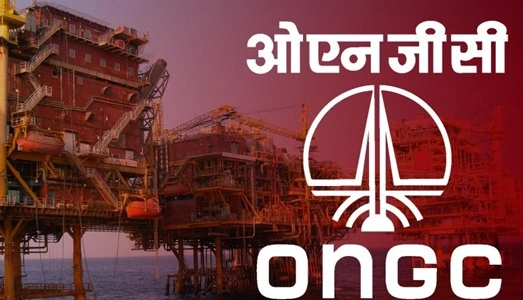Oil and Natural Gas Corporation Ltd, ONGC in short, is the largest oil and gas producer in India that explores, extracts, refines, and sells oil and natural gas. ONGC is also growing in the petrochemicals and renewable energy sectors. Due to the broad position in the energy sector of India, ONGC plays a key role in the economy and energy security.
ONGC was established in 1956 by the government of India. Over the years, ONGC has grown across the country. Exploration of new energy sources is capital-intensive, but it has made a fortune over the years by selling energy to the whole country. Now, ONGC invests heavily in exploration, drilling, infrastructure, and environmental management.
There are multiple sources of revenue used by ONGC to keep floating with major revenue while investing heavily in the exploration of new sites.

How is the ONGC Business Model Structured?
ONGC’s core business strategy is around upstream oil and gas exploration and production. That means locating oil/natural gas reserves, drilling wells (onshore & offshore), extracting crude oil and gas, and selling them. ONGC owns many blocks in India, and it operates them. There are also subsidiaries and joint operations in refining, petrochemicals, and power generation.
Recently, ONGC’s structure has been about diversification as it started expanding into renewables, green energy, trading, and similar sectors. ONGC Green Ltd is acquiring renewable energy assets (wind, solar) to meet targets. ONGC also invests in petrochemicals, plastics, and other value-added divisions (subsidiaries like OPaL).
| Company/Brand | Oil & Natural Gas Corporation Ltd (ONGC) |
| Establishment Year | 1956 (originally set up as Oil & Natural Gas Directorate in 1956; merged to form ONGC in 1959) |
| Headquarters | New Delhi, India |
| Founder/Owner | Government of India; Public Sector Undertaking under the Ministry of Petroleum & Natural Gas |
| Industry | Oil & Gas (Exploration, Production), Petrochemicals, Refining, Renewables |
| Net Worth (2025) | Standalone PAT: ~ ₹ 35,610 crore; Consolidated PAT: ~ ₹ 38,329 crore |
| Total Revenue 2025 | Standalone revenue from operations: ₹ 1,37,846 crore; Consolidated revenue ~ ₹ 6,63,262 crore (or higher in some reports) |
How Does ONGC Make Money?
As mentioned earlier, ONGC has multiple streams; diversification plays a key role when its main source of revenue is dealing with poor growth. The following are key strategies used by ONGC to make money:
1. Crude Oil Extraction and Sales
The primary source of revenue is quite easy to guess. Well, ONGC explores for oil and drills wells, then produces crude oil. This oil is refined and sold for energy purposes. The prices of oil affect earnings heavily. Most of this oil is used for domestic purposes, while a small portion is still traded in international markets.
2. Natural Gas Production and Sales
ONGC produces natural gas, both domestically and overseas, via joint ventures. Gas is sold to the domestic market, such as industries, power plants, fertilizers, and similar places. It also sells gas at regulated and market rates based on the policy. With the help of the gas selling business, ONGC can diversify its income and make steady revenue, as the demand is always high.
3. Petrochemicals and Downstream Value Addition
Through its subsidiary or newly acquired arms (like OPaL – ONGC Petro Additions), ONGC processes crude derivatives to make polymers and chemicals. These downstream operations add value, often can fetch higher margins than raw crude, though they require high capital and involve operational and feedstock cost risk.
4. Overseas Operations
ONGC Videsh or OVL is a subsidiary of ONGC that operates overseas. This includes exploration and production in the overseas fields. The revenue that ONGC generates from abroad usually helps in foreign exchange earnings and diversifies geopolitical risks. However, there are multiple risk points in the cost of operations, taxation, and regulatory compliance as well.
5. Royalties and Government Concessions
As a government-owned company, ONGC is subject to royalty payments, taxes, and statutory levies. However, due to government policies like price guarantees for new wells, prescribed rates for natural gas from certain blocks, and similar operations, the realization improves. On the other hand, ONGC remunerates the government through dividends and exchequer contribution because these policies affect both sides of the business, revenue and costs.
Financial Performance
In 2025 alone, ONGC’s standalone revenue from operations was around ₹1,37,846 crore, almost similar to last year. The company’s standalone profit after tax (PAT) reduced to 35,610 crore, which was a 12% dip from 2024. However, if we look at a consolidated basis, revenue stood at around ₹6,63,362 crore with a consolidated PAT of ₹38,329 crores.
What’s new in 2025?
ONGC is pushing toward renewable energy by expanding into the green energy sector. The subsidiary brand of ONGC has acquired wind/solar assets like PTC Energy and Ayanna Renewables, to target 10GW renewable energy capacity by 2030. Overall in FY25, ONGC drilled about 578 wells, the highest in 35 years, and there were about nine hydrocarbon discoveries, with 2 pool discoveries.



